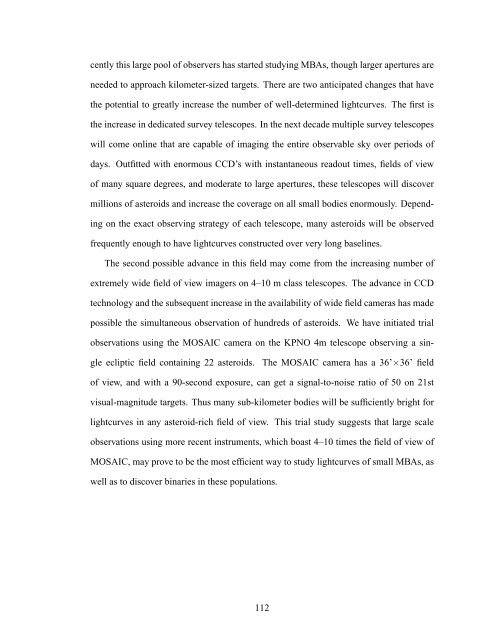Forming Binary Near-Earth Asteroids From Tidal Disruptions
Forming Binary Near-Earth Asteroids From Tidal Disruptions
Forming Binary Near-Earth Asteroids From Tidal Disruptions
Create successful ePaper yourself
Turn your PDF publications into a flip-book with our unique Google optimized e-Paper software.
cently this large pool of observers has started studying MBAs, though larger apertures areneeded to approach kilometer-sized targets. There are two anticipated changes that havethe potential to greatly increase the number of well-determined lightcurves. The first isthe increase in dedicated survey telescopes. In the next decade multiple survey telescopeswill come online that are capable of imaging the entire observable sky over periods ofdays. Outfitted with enormous CCD’s with instantaneous readout times, fields of viewof many square degrees, and moderate to large apertures, these telescopes will discovermillions of asteroids and increase the coverage on all small bodies enormously. Dependingon the exact observing strategy of each telescope, many asteroids will be observedfrequently enough to have lightcurves constructed over very long baselines.The second possible advance in this field may come from the increasing number ofextremely wide field of view imagers on 4–10 m class telescopes. The advance in CCDtechnology and the subsequent increase in the availability of wide field cameras has madepossible the simultaneous observation of hundreds of asteroids. We have initiated trialobservations using the MOSAIC camera on the KPNO 4m telescope observing a singleecliptic field containing 22 asteroids.The MOSAIC camera has a 36’×36’ fieldof view, and with a 90-second exposure, can get a signal-to-noise ratio of 50 on 21stvisual-magnitude targets. Thus many sub-kilometer bodies will be sufficiently bright forlightcurves in any asteroid-rich field of view. This trial study suggests that large scaleobservations using more recent instruments, which boast 4–10 times the field of view ofMOSAIC, may prove to be the most efficient way to study lightcurves of small MBAs, aswell as to discover binaries in these populations.112












